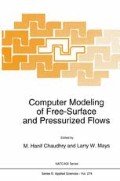Abstract
As a numerical technique the boundary integral equation method has a number of outstanding advantages. These include: Problems are much easier to set up; it requires less data to define the grid; it is efficient, using less computer time and storage than finite differences and finite elements; approximations are confined to the boundaries giving interior solutions with at least as much accuracy; it has better accuracy than finite differences and finite elements for equal discretization; one can use intuitive grid spacing since derivatives are not approximated; velocities are obtained without inaccurate numerical differentiation; singularities are easily handled; infinite fields are easily handled; universal programs are easy to code; it has geometric flexibility; the grid size is easy to vary; and it can use a variety of approximations to conform to the demands of the problem and the desired degree of continuity. With that list of advantages, it should be a universal method that displaces all other methods. Indeed it would except for one disadvantage: The variety of problems it can solve — or at least the variety of problems it can solve while retaining all those advantages — is small.
Access this chapter
Tax calculation will be finalised at checkout
Purchases are for personal use only
Preview
Unable to display preview. Download preview PDF.
References
Hall, W. S., and T. T. Hibbs, “The treatment of singularities and the application of the Overhauser C1 continuous quadrilateral boundary element to three dimensional elastostatics,” in Advanced Boundary Element Methods (T. A. Cruse, ed.), Springer-Verlag, 1988, pp. 135–143.
Liggett, J. A., and J. R. Salmon, “Cubic spline boundary elements,” International Journal for Numerical Methods in Engineering, Vol. 17, April, 1981, pp. 543–556.
Liggett, J. A., “Free surface flow -exposing the hidden nonlinearity,” Communications in Applied Numerical Methods, Vol. 4, 1988, pp. 509–516.
Medina, D. E., J. A. Liggett, R. A. Birchwood, and K. E. Torrance, “A consistent boundary-element method for free-surface hydrodynamic calculations,” International Journal for Numerical Methods in Fluids, Vol. 12, 1991, pp. 835–837.
Medina, D. E., and J. A. Liggett, “Exact integrals for three dimensional boundary element potential flow,” Communications in Applied Numerical Methods, Vol. 5, November, 1989, pp. 555–561.
Mei, C. C, “Numerical methods in water-wave diffraction and radiation,” Annual Review of Fluid Mechanics, Vol. 10, 1978, pp. 393–416.
Stoker, J. J., Water Waves, Interscience, New York, 1957.
Author information
Authors and Affiliations
Editor information
Editors and Affiliations
Rights and permissions
Copyright information
© 1994 Springer Science+Business Media Dordrecht
About this chapter
Cite this chapter
Liggett, J.A. (1994). Boundary Integral Equation Method for Free Surface Flow Analysis. In: Chaudhry, M.H., Mays, L.W. (eds) Computer Modeling of Free-Surface and Pressurized Flows. NATO ASI Series, vol 274. Springer, Dordrecht. https://doi.org/10.1007/978-94-011-0964-2_4
Download citation
DOI: https://doi.org/10.1007/978-94-011-0964-2_4
Publisher Name: Springer, Dordrecht
Print ISBN: 978-94-010-4417-2
Online ISBN: 978-94-011-0964-2
eBook Packages: Springer Book Archive

